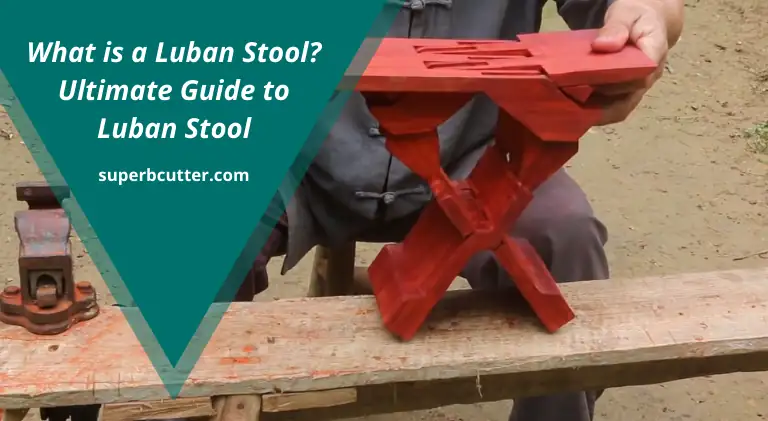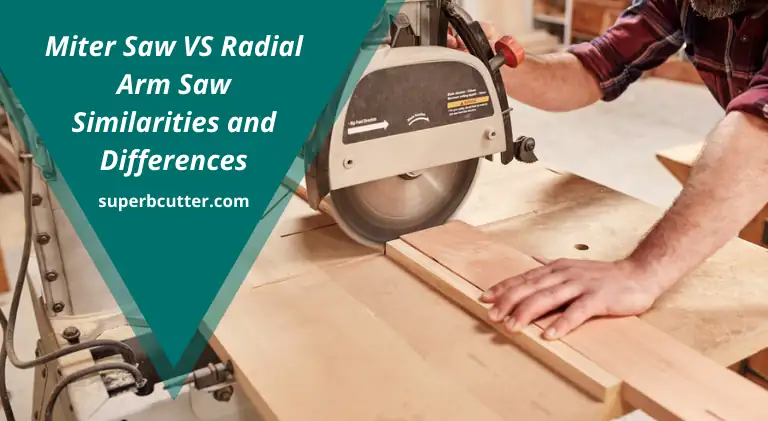Can Miter Saws Cut Metal? [Common Myth about Miter Saw]
Miter saws are a commonly used power tool for making precise, angled cuts in various materials, including wood, plastic, and composite materials. But what about metals? Can miter saws cut metal?
Yes, miter saws can cut metal, provided the saw has a metal cutting blade with an appropriate number of teeth and RPM.
But, as with any tool, you should follow certain precautions and techniques to ensure safety and accuracy.
In this article, I’ll go over everything you need to know about using a miter saw to cut metal, including the different blades you can use, the safety measures you should take, and some tips and tricks to get the best results.
So, if you want to take your metalworking skills to the next level, keep reading!
Can Miter Saws Cut Metal?
Yes, it is technically possible to cut metal with a miter saw, but it is not the primary function of this tool, and there are several important considerations to keep in mind.
Miter saws are designed to make precise, angled cuts in wood, plastic, and composite materials using a circular blade that rotates at high speed.
The blade is mounted on an adjustable arm that allows the user to make various cuts, including cross cuts, miter cuts, and bevel cuts.
The Basics of Miter Saws
A miter saw is a versatile and powerful tool used to make precise cuts in various materials, including wood, plastic, and metal.
It is an essential tool for any carpenter, woodworker, or DIY enthusiast who wants to create perfect cuts with ease and accuracy.
Let’s discuss the basics of miter saws, including what they are, the types of miter saws available, the parts of a miter saw, and how it works.
Types of Miter Saws
Several types of miter saws are available on the market, each designed for different cutting applications. Some of the most common types of miter saws include:
- Standard Miter Saw: This is the most basic type of miter saw, designed for making simple crosscuts and angle cuts in wood and other materials.
- Compound Miter Saw: This miter saw allows the blade to tilt in one direction while the arm pivots in the other, making it ideal for making bevel cuts.
- Sliding Compound Miter Saw: This is an advanced version of the compound miter saw with a sliding mechanism that allows the blade to move forward and backward. This type of miter saw is perfect for cutting wider boards and other large materials.
- Dual-Compound Miter Saw: This type of miter saw is similar to the compound miter saw but has the added feature of being able to tilt in both directions, making it ideal for making compound angle cuts.
A miter saw consists of several parts that work together to make precise cuts. Some of the most important parts of a miter saw include:
- Blade: This is the circular saw blade that makes the cuts in the material.
- Motor: This powers the blade and controls its speed.
- Arm: This holds the blade and pivots to make the angled cuts.
- Fence: This keeps the material in place during the cutting process.
- Base: This is the flat surface on which the saw rests and provides stability.
To use a miter saw, the material is placed against the fence, and the blade is lowered onto the material to cut. The angle and bevel settings are adjusted to the desired angles before making the cut.
When the saw is activated, the blade spins and makes the cut, with the material remaining securely against the fence. The precision and accuracy of a miter saw make it an indispensable tool for many woodworking and carpentry projects.
How to Use a Miter Saw to Cut Metal?
Use a Metal Cutting Blade
When it comes to cutting metal, the type of blade used and the speed at which it rotates can affect the efficiency and quality of the cut. There are some good quality metal cutting blades available on the market nowadays, such as the “Freud LU85R012“
For example, using a correct blade with a high tooth count (e.g., 40-80 teeth) can produce a smoother finish but may result in slower cutting speeds. Alternatively, a blade with a lower tooth count (e.g. 10-20 teeth) may cut more quickly but leave a rougher finish.
Metal Thickness and Limitations of Miter Saws
In addition to the metal cutting blade, the type of metal being cut and its thickness can also impact the saw’s performance. Thicker metals may require a slower cutting speed and a ferrous metal cutting blade with a higher tooth count to prevent overheating and distortion of the material.
Soft metals, such as aluminum, may be easier to cut but can still present challenges, such as the tendency to bind or twist even the metal cutting blade.
It is important to note that miter saws are not designed to handle the extreme heat and forces involved in cutting metal and using them for this purpose can result in damage to the tool and potentially even injury to the operator.
Other tools are better suited for cutting metal, such as circular saws, jigsaws, chop saws, and band saws, which have stronger motors and more durable blades.
Which Blade Is Good for Cutting Metal: Choosing the Right Blade
As far as I have learned from different sources and from my experience, I found the diamond blades and carbide ones quite effective. Also, any 12-inch metal cutting blade for a miter saw will be good.
Make sure you get something abrasive in nature to cut the metal. It will help you complete the project safely without putting too much load on your saw. Apart from that, it will also make sure that a minimum amount of chips fly away. If you want to make precise cuts, you should look for a blade with more teeth.
Blades with more teeth can give cleaner outputs even on the hardest subjects such as steel. However, blades with more teeth are relatively slower when making metal cuts. On the other hand, the blade with fewer teeth can do the job quickly but you can’t expect very smooth outputs.
Different Types of Saw Blades and Their Usage
| Blade Type | Function |
| Crosscutting blades | designed for cutting along the material’s grain, usually to create a rough, rough-cut edge. They typically have a low number of teeth and a shallow hook angle, which allows them to remove material quickly but leaves a rough, rough finish. |
| Ripping blades | They are used for both crosscutting and ripping and are good all-purpose blades for general woodworking tasks. They have a medium number of teeth and a moderate hook angle, which allows them to make both clean crosscuts and rough rip cuts. |
| Combination blades | Designed for creating wide, flat-bottomed wood cuts, such as dado joints or grooves. They have a series of stacked teeth that allow them to remove a wide swath of material in a single pass. |
| Dado blades | Used for cutting through laminate flooring, countertops, and other laminate materials. They have many teeth and a steep hook angle to minimize chipping and create clean, precise cuts. |
| Plywood blades | Designed specifically for cutting through plywood and other laminated materials. They have many teeth and a steep hook angle to minimize tear-out and create clean, accurate cuts. |
| Laminate blades | Used for cutting through laminate flooring, countertops, and other laminate materials. They have a high number of teeth and a steep hook angle to minimize chipping and create clean, precise cuts. |
| Non-Ferrous blades | Used for cutting through non-ferrous metals, such as aluminum, brass, and copper. They have many teeth and a special tooth geometry that allows them to make clean, precise cuts without binding or overheating. |
Blade Tooth Configuration
Blade tooth configuration refers to the shape and arrangement of the teeth on a saw blade. The type of tooth configuration can affect the speed and quality of the cut, as well as the lifespan of the blade.
Some common blade tooth configurations include:
Flat top teeth have a straight, flat top edge perpendicular to the blade body. They are typically found on crosscutting blades and are designed to make precise, clean cuts with minimal tear-out.
Alternate top bevel (ATB) teeth have a sloping top edge alternating between left and right bevels. They are typically found on crosscutting blades designed to produce a clean finish with minimal tear-out.
Triple chip grind (TCG) teeth have a three-faceted tooth geometry designed to remove material efficiently and minimize heat buildup. They are typically found on ripping blades and abrasive wheels and are designed to make rough, rough-cut edges.
Raker’s teeth have a series of alternating large and small teeth that are designed to remove material efficiently and reduce heat buildup. They are typically found on ripping blades and are designed to make rough, rough-cut edges.
Chipper teeth have a series of small, alternating teeth designed to remove material efficiently and reduce heat buildup. They are typically found on dado blades and designed to create wide, flat-bottomed cuts.
Choosing the right blade tooth configuration depends on the cut type and the material being cut. For example, a blade with ATB teeth would be well-suited for making clean crosscuts in wood, while a blade with TCG teeth would be better suited for rough rip cuts.
Can Miter Saws Cut Metal With a Wood Blade?
I wouldn’t recommend cutting metal with a regular wood blade. It is because wood blades aren’t rated for heavy-duty tasks. If you want to use them on steel projects, these blades will produce a lot of friction. It is due to the high RPM of the blade, which is usually good for softer subjects like wood and aluminum.
Higher friction will produce a lot of heat, making the blade and the subject very hot. Apart from that, it also puts too much pressure on the motor which can reduce the performance of the motor with time.
Can a Miter Saw Cut Lengthwise?
Miter saws are specifically used for making angled cuts. Although it can make straight/crosscuts quite efficiently there are some limitations. Due to the fixed arm length and area on the table of the miter saw you may be unable to cut too lengthy boards with a miter saw lengthwise.
Can I use Miter Saw to Cut PVC?
Yes, miter saws are awesome tools for cutting PVC pipes. Especially when you want to get some cool angled cuts. However, just like metal cutting projects, you must equip your miter saw with a carbide tip blade. Usually, blades with a higher number of teeth are highly recommended.
That said, you must be very careful when cutting PVC pipes with miter saws. It is because using an abrasive blade will sometime ruin the smoothness of the blade. Now if you have already made proper calculations. Even a small wrong cut will make a real mess during the project.
Using Other Tools for Metal Cutting Projects
If you don’t want to use your miter saw for metal cutting, you can use other tools well. For example, a circular or table saw can be useful for such things. You can cut without using any machinery at all. However, it will take very long, which is not recommended.
Imagine using a miter box for cutting a lot of steel. It will take you hours to complete the project. Apart from that, you can always use some life hacks and DIY tools. But that will require a lot of creativity.
Safety Consideration for Cutting Metal with Miter Saw
Before you put steel or any other metal for cutting in a miter saw, you need to take some safety measures. These safety measures will ensure you get the maximum output without any accidents.
So without any further ado, let’s look at some of the most important points you need to take care of.
- Always make sure you have safety on. Never use a saw without properly covering your eyes and wearing gloves.
- Ensure the saw is secured properly and won’t slip or fall off from where you are using it.
- Try to put the steel or any other type of metal properly under the blade
- Always double-check your calculations before cutting the metal
- Never use a low-quality blade on your miter saw
- Always use lubricants when working on steel, aluminum, or other metal.
What Material can you cut with a miter saw?
Miter saws are quite versatile, provided that you use the right blade type for the job. If you want to use your saw for projects other than woodworking, you will need different blades. You can use your miter saw to cut bricks, steel, aluminum, PVC, brass, and even copper.
However, some people don’t agree as the speed of the saw is quite high, and it will produce a lot of heat. That said, if you have taken the safety measures, you will be good to go without any issues.
Can a Miter Saw Cut Aluminum?
Another question that comes into mind is whether a miter saw can cut aluminum or not. The answer to this question is yes; cutting aluminum with a miter saw is possible.
However, you should get a metal cutting blade for a miter saw to do this job efficiently. Apart from that, you should also keep the material’s thickness in mind.
If the aluminum piece is too thick, you should avoid using a miter saw instead of a chop saw.
Can a Miter Saw Cut Tiles?
Tiles are a bit challenging to cut, especially when trying a miter saw for the project. You can cut the tile without any issues. However, you need to be a little creative. The problem with cutting tiles on a miter saw is that they produce a lot of dust.
It will make a mess, and that dust also harms health. Therefore, using some lubricants, you need to make the tile a little bit wet. Also, ensure you have covered your face properly during the job.
Conclusion
Can you cut metal with a miter saw? Most people have this question in mind, especially when trying their miter saw for the first time. I didn’t even know the ABC of miter saws when I started learning about them.
However, with time and my own experiments, I learned that you could convert a miter saw to cut metal with the miter saw metal blade and speed. Once you figure out how to do it properly, it will help you a lot on your projects.
If you would like to add anything to this post or any insight you have on this subject, please feel free to comment below.




